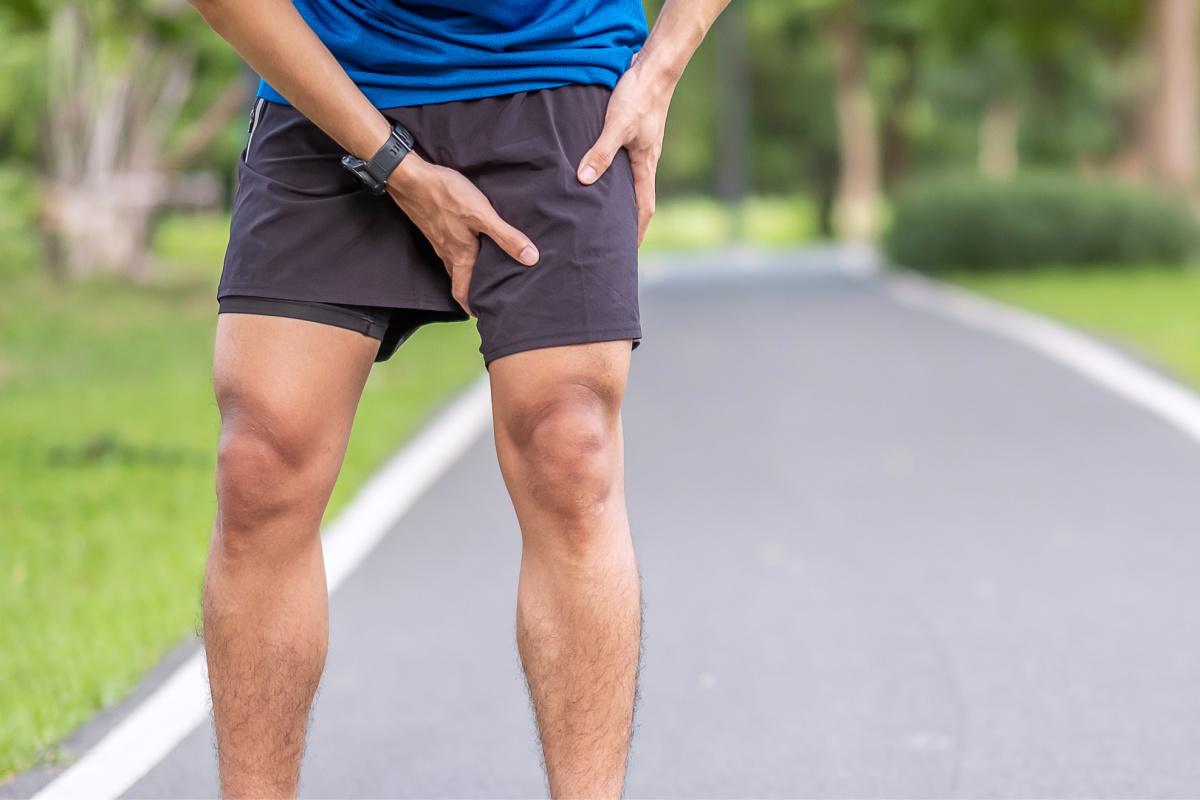A sudden jolt of pain while working out can be frightening, especially when it occurs in a more sensitive area, such as the groin or lower abdomen. Oftentimes, this type of discomfort can be due to some type of muscle strain, which is not usually a cause for true concern. However, in rarer yet more serious situations, a hernia could be the culprit. When trying to determine sports hernia vs groin strain in your situation, you need to know the facts so you can take the right actions to resolve your pain.
Sports Hernia vs Groin Strain: What’s the Difference?
A groin strain is a relatively common injury, especially for those who play a sport that requires jumping, quick movement, and fast reflexes, such as:
- Tennis
- Basketball
- Soccer
- Hockey
- Football
- Running
It’s important to remember that you don’t have to be a professional athlete to suffer from serious exercise injuries. In fact, those who play for leisure are still very likely to sustain sports injuries, especially as they age. Muscle strains and cramps are some of the most common, and groin strains in particular can be very painful.
They are often identified by a sharp pain inside the upper thigh. Sometimes, you may experience a snapping or popping sensation before the pain begins. The discomfort tends to worsen when lifting your knee on the affected side or closing your legs together.
Sometimes a groin strain is referred to as a sports hernia because the pain can be so intense, affects a specific similar area, and can lead to loss of function or strength. However, these injuries are not hernias, so the term can be misleading. A true hernia (called an inguinal hernia in the groin area) involves the breakdown and separation of muscle tissue to the point that fatty tissue or part of the digestive tract protrudes through. In addition to severe pain, you can palpate a bulge or knot at the site.
The Causes of Groin Strains and Hernias
Groin strains can occur when the affected muscles are rapidly or intensely tensed or pulled, resulting in overstretching or tearing. This tends to happen with quick, deep, sudden leg movements. People who fail to stretch properly before and after exercising are more prone to muscle strain. Dehydration can also play a role.
While the protrusion from a hernia often occurs during a specific incident, it is often the result of long-term wear and tear rather than instant or sudden movement. People with underlying conditions or certain medical histories are more at risk for developing an inguinal hernia. Those with a family history of the issue, as well as those with a chronic or persistent cough, are also more apt to experience one. Hernias are more prevalent in men: They occur in 33% of males but only 10% of females, mainly due to anatomical differences.
Treatment Options for Abdominal Muscle Injuries
Because a sports hernia or groin strain affects the abdominal muscles, pain management may look similar in mild cases. Severe injuries require a more unique and in-depth approach.
Groin Strain
Groin strains mostly require rest and time to resolve. In the meantime, a doctor may recommend ice packs to control swelling, anti-inflammatory painkillers for discomfort, and compression of the area with an ace bandage or athletic tape. Those with more severe injuries may benefit from physical therapy and a regimen of specific stretches and exercises to restore function and strength.
Inguinal Hernia
Unlike muscle strains, inguinal hernias do not improve on their own with time. In fact, they tend to worsen. While it is possible to press the protruding area back behind the abdominal wall, it typically falls forward again within a few minutes, especially with movement. The only way to repair a hernia is through surgery to fix the opening in the muscle.
Surgery is not always necessary right away; some people choose to wait until symptoms worsen or the pain becomes more permanent. However, inguinal hernias do increase the chances of developing a bowel obstruction, which can be life-threatening. A doctor can help patients weigh the pros and cons of waiting for surgery.
FAQs About Groin Strains and Sports Hernias
The more you know about these two injuries, the more confident you can feel in identifying and managing them.
Can a Groin Injury Mimic a Hernia?
Symptoms between the two can feel very similar. However, a strained muscle does not result in a bulge or knot in the area. If this symptom develops, a hernia is likely the cause.
How Do You Rule Out a Sports Hernia?
The only way to know for sure whether a person has an actual sports hernia vs a groin strain is to see a medical professional. A physical exam may suffice for an accurate diagnosis, especially in severe cases. Some patients also need medical imaging to accurately identify the injury.
Is Surgery Always Necessary for Hernias?
The body cannot repair a hernia on its own, but if the damage is minor with little to no tissue protrusion, hernia surgery can sometimes wait. Doctors may not recommend surgery for those who are at high risk for complications, such as the elderly and the immunocompromised.
Is a Groin Strain a Serious Injury?
Muscle strain happens to most people at some point, especially those who lead an active lifestyle. While a groin strain is in a sensitive area, it is usually no cause for concern. If the condition is recurring or leads to serious mobility issues, it may require surgical repair, but this is rare.
Sports Hernia vs Groin Stain: Get the Expert Help You Need
When it comes to identifying an inguinal sports hernia vs groin strain, you need expert medical care and advice to treat your pain. At Arizona Premier Surgery, we understand that your health and quality of life are both of the utmost importance. We offer in-depth consultations you can trust, with treatment plans designed to meet your specific needs. If surgery is in your future, we offer the latest minimally invasive procedures so your recovery can be as fast and effortless as possible. Contact us today to learn more about the services available to you.
Sources:




